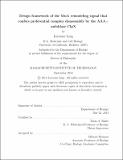Design framework of the MuA remodeling signal that confers preferential complex disassembly by the AAA+ unfoldase ClpX
Author(s)
Ling, Lorraine, Ph. D. Massachusetts Institute of Technology
DownloadFull printable version (17.77Mb)
Other Contributors
Massachusetts Institute of Technology. Department of Biology.
Advisor
Tania A. Baker.
Terms of use
Metadata
Show full item recordAbstract
The cell employs many classes of molecular chaperones to facilitate proteins in adopting the proper structure and preventing non-functional and potentially toxic non-native states. The Clp/Hsp100 family of ATPases are unfolding chaperones that remodel macromolecular complexes and facilitate ATP-dependent protein degradation. They are members of the superfamily of AAA+ enzymes (ATPases Associated with various cellular Activities), which is conserved across all kingdoms of life. Efficient selection of multimeric protein complexes over constituent subunits is key to successful remodeling and disassembly reactions. Using E.coli ClpX as a model for AAA+ ATPases, I characterized the mechanism by which ClpX discriminates between two oligomeric states of one of its natural multimeric substrates, phage MuA tranposase. I elucidated many strategies for ClpX's preference for the assembled Mu transpososome (MuA complex) over unassembled subunits. First, the target substrate makes multiple weak interactions with the AAA+ ATPase via the pore in the conserved ATPase domain and a class-specific auxiliary domain. Second, recognition tags should be at the weaker end of the affinity spectrum to allow effective synergy of multiple tags in the assembled complex. Third, multimeric complexes can "divide the labor" of making these interactions among their subunits. Thus the holistic complex-specific targeting signal is accessible only in the assembled complex. The work of this thesis has provided a framework to understand the design of recognition signals that specify and target macromolecular complexes to unfolding chaperones and remodelers of the AAA+ superfamily.
Description
Thesis: Ph. D., Massachusetts Institute of Technology, Department of Biology, 2014. This electronic version was submitted by the student author. The certified thesis is available in the Institute Archives and Special Collections. Cataloged from student-submitted PDF version of thesis. Includes bibliographical references (pages 77-87).
Date issued
2014Department
Massachusetts Institute of Technology. Department of BiologyPublisher
Massachusetts Institute of Technology
Keywords
Biology.